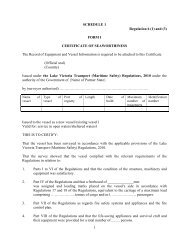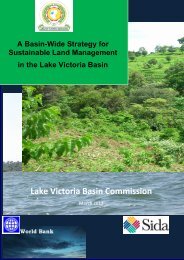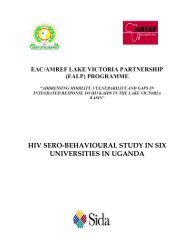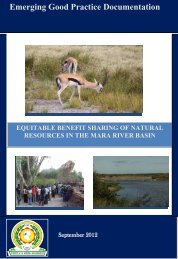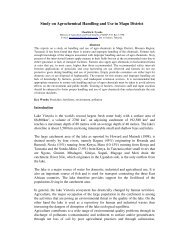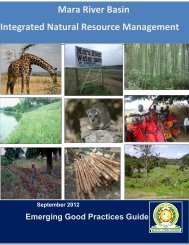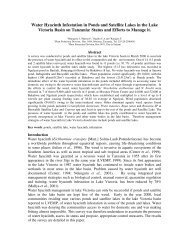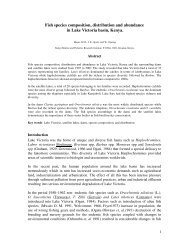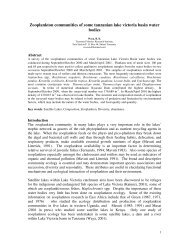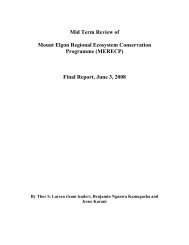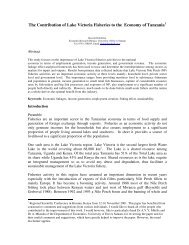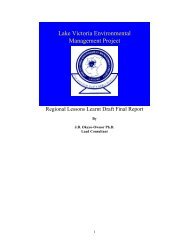Total Economic Value of Maasai Mau, Trans Mara and Eastern Mau ...
Total Economic Value of Maasai Mau, Trans Mara and Eastern Mau ...
Total Economic Value of Maasai Mau, Trans Mara and Eastern Mau ...
Create successful ePaper yourself
Turn your PDF publications into a flip-book with our unique Google optimized e-Paper software.
For the local communities living near the forest blocks, the main value <strong>of</strong> the forests ishidden in the productive potential <strong>of</strong> the l<strong>and</strong> that is under the trees. To this group, thevalue <strong>of</strong> the forest can be measured by the capital value <strong>of</strong> the l<strong>and</strong> in the otherintended uses. This can be captured using the present value <strong>of</strong> the annual or periodicnet returns from using the l<strong>and</strong> for those other purposes, minus the cost <strong>of</strong> clearing theforest <strong>and</strong> planting the new crop. The most important crops are wheat in the southernpart <strong>of</strong> the <strong>Maasai</strong> <strong>Mau</strong> <strong>and</strong> tea growing in the other part <strong>of</strong> the forest blocks. The mainargument in the valuation using opportunity cost is that when the forests are convertedinto agricultural l<strong>and</strong>, the community loses all other benefits. The decision will involvecost <strong>and</strong> benefit analysis <strong>of</strong> the alternative uses <strong>of</strong> the forests.Forests have been the main source <strong>of</strong> l<strong>and</strong> for various l<strong>and</strong> uses for the community <strong>and</strong>are part <strong>of</strong> way <strong>of</strong> life practised over many years. The settlements <strong>and</strong> encroachmentinto most <strong>of</strong> the three forest blocks currently taking place in most cases is for cropproduction for subsistence <strong>and</strong> cash generation. Thus the opportunity cost <strong>of</strong>conserving the <strong>Mau</strong> Forest complex is measured realistically by the foregone conversioninto alternative l<strong>and</strong> use currently undertaken in adjacent farms.The l<strong>and</strong> use currently practised by farmers <strong>and</strong> companies operating in farms adjacentto the selected forest blocks is farming, mostly tea, maize <strong>and</strong> potatoes. For this studywe take tea <strong>and</strong> maize as the best alternative uses to the three forest blocks. To bring inthe forest angle we shall consider the Eucalyptus gr<strong>and</strong>is that is currently theremunerative forestl<strong>and</strong> use adopted by many farmers in the region. Comparative l<strong>and</strong>use studies by Cheboiwo <strong>and</strong> Langat (2008) using discounted cost–benefit analysisshowed range <strong>of</strong> performance <strong>of</strong> the three l<strong>and</strong> uses:n( Bt− Ct)NPV= ∑t(1 rt= 1 + )(4)Where, NPV is the net benefit present value <strong>of</strong> the enterprise under consideration; Bt isthe benefit generated in each year in KES; Ct = Cost in each year in KES; n is the rotation<strong>of</strong> the selected crop; r is the discount rate used to bring the benefits to the current values;<strong>and</strong> t is the time series under consideration.For ease in comparison another tool equal annual equivalent is introduced as follows:EAE = NPV × annuity factor (5)where annuity factor = r (1 + r) t /(I + r) t-1 (6)50



